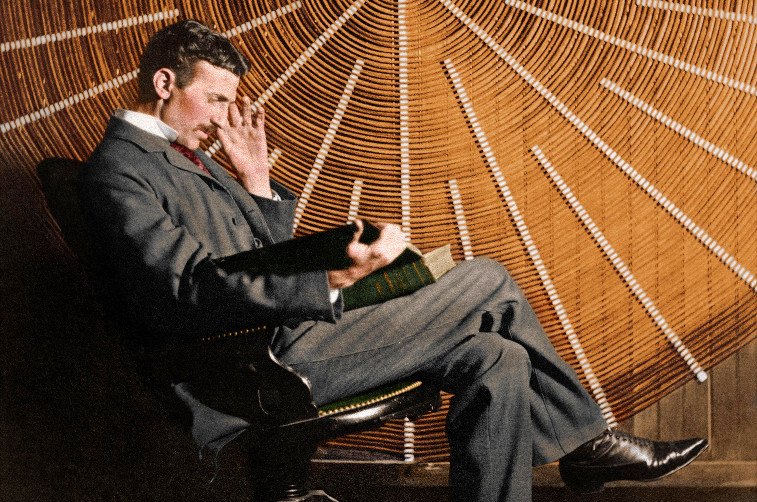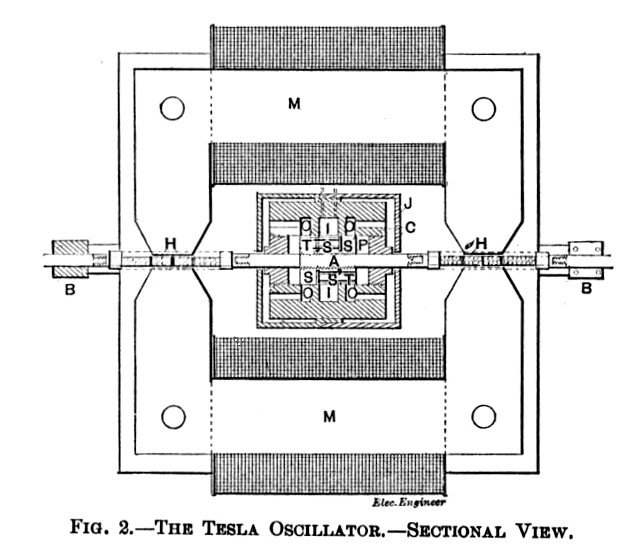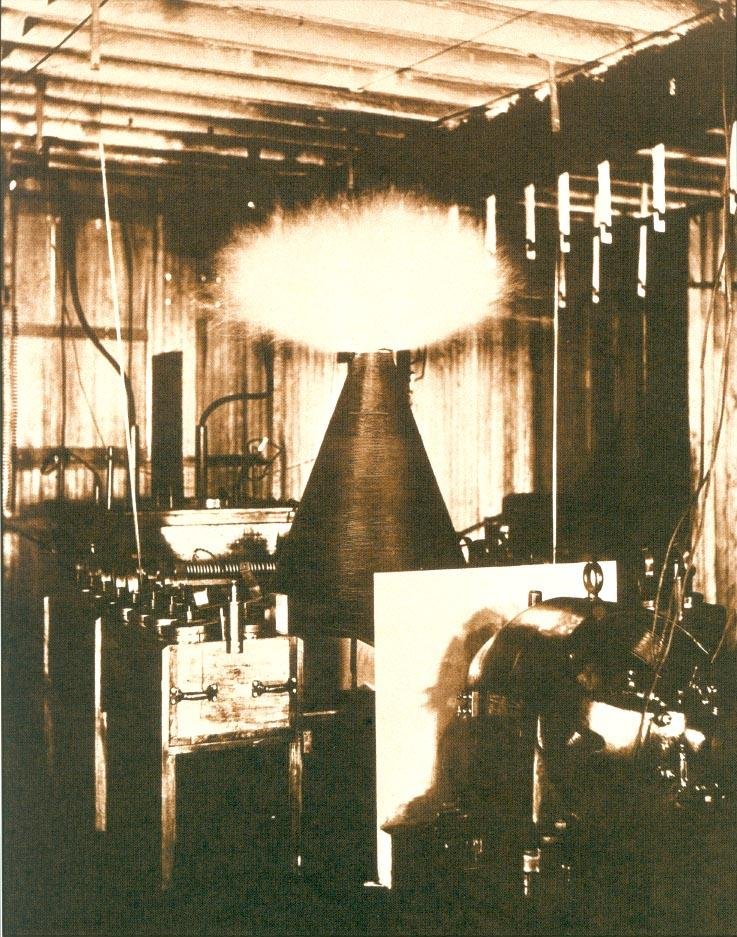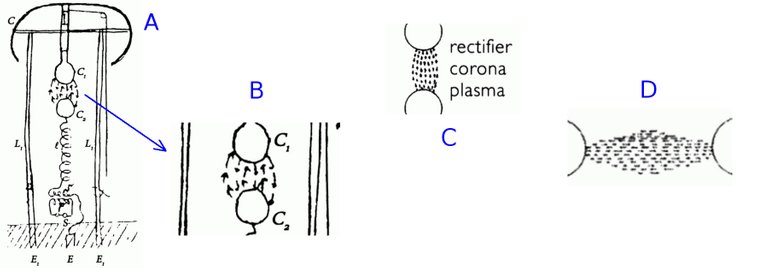Here we are in 2018, over a hundred years later speculating about what could have been Nikola Tesla’s secret. I then think to myself: if only I could show you what I read, you would understand that there is no secret. When I read his articles and patents from 1900 onward, what I see is a man desperately trying to get his views across. He tries again and again in many different ways, but no-one seems to see what I see.

(Some internet fools say that Tesla is reading Boskovich here. As anyone can read in the article of May 20th, 1896 “Tesla’s Important advances”, he was reading one of the "Scientific Papers" of Maxwell)
It is my sincere wish that one day people will read Tesla’s articles and really understand what he is saying.
So… Let me take you by the hand an walk you through his most famous article: “The Problem of Increasing Human Energy”, published in Century Illustrated Magazine of June 1900.
After having explained the working principles Tesla now moves on to explaining the apparatus required to accomplish this process. This is what most people consider Tesla’s secret; his source of “free energy”. But as you can see here, he explains it in full. To link this self acting engine to the magnifying transmitter (which is the same thing) you will need to compare this part to chapter 5 of Tesla’s autobiography and pay special attention to the dates he mentions (btw also in the new process to manufacture iron, which is dated by Tesla 6 years before this article or in 1894).
Previous parts can be found here:
Part 1: Laying a foundation
Part 2: What is electricity?
Part 3: Burning Nitrogen...
Part 4: How to overcome natural resistance
Part 5: Telautomatics
Part 6: Introduction to Harnessing the Sun’s Energy
Part 7: The Manufacture of Iron? Or ...
Part 8: The coming age of aluminium
Part 9: The cold-coal battery
Part 10: Energy from the medium
Part 11: A departure from known methods
We continue in the main article where we’d left off.
FIRST EFFORTS TO PRODUCE THE SELF-ACTING ENGINE
—THE MECHANICAL OSCILLATOR—WORK OF DEWAR AND LINDE—LIQUID AIR.
Having recognized this truth, I began to devise means for carrying out my idea, and, after long thought, I finally conceived a combination of apparatus which should make possible the obtaining of power from the medium by a process of continuous cooling of atmospheric air. This apparatus, by continually transforming heat into mechanical work, tended to become colder and colder, and if it only were practicable to reach a very low temperature in this manner, then a sink for the heat could be produced, and energy could be derived from the medium. This seemed to be contrary to the statements of Carnot and Lord Kelvin before referred to, but I concluded from the theory of the process that such a result could be attained. This conclusion I reached, I think, in the latter part of 1883, when I was in Paris, and it was at a time when my mind was being more and more dominated by an invention which I had evolved during the preceding year, and which has since become known under the name of the "rotating magnetic field." During the few years which followed I elaborated further the plan I had imagined, and studied the working conditions, but made little headway. The commercial introduction in this country of the invention before referred to required most of my energies until 1889, when I again took up the idea of the self-acting machine. A closer investigation of the principles involved, and calculation, now showed that the result I aimed at could not be reached in a practical manner by ordinary machinery, as I had in the beginning expected. This led me, as a next step, to the study of a type of engine generally designated as "turbine," which at first seemed to offer better chances for a realization of the idea. Soon I found, however, that the turbine, too, was unsuitable. But my conclusions showed that if an engine of a peculiar kind could be brought to a high degree of perfection, the plan I had conceived was realizable, and I resolved to proceed with the development of such an engine, the primary object of which was to secure the greatest economy of transformation of heat into mechanical energy. A characteristic feature of the engine was that the work-performing piston was not connected with anything else, but was perfectly free to vibrate at an enormous rate. The mechanical difficulties encountered in the construction of this engine were greater than I had anticipated, and I made slow progress. This work was continued until early in 1892, when I went to London, where I saw Professor Dewar's admirable experiments with liquefied gases. Others had liquefied gases before, and notably Ozlewski (Karol Stanistaw Olszewski) and Pictet had performed creditable early experiments in this line, but there was such a vigour about the work of Dewar that even the old appeared new. His experiments showed, though in a way different from that I had imagined, that it was possible to reach a very low temperature by transforming heat into mechanical work, and I returned, deeply impressed with what I had seen, and more than ever convinced that my plan was practicable. The work temporarily interrupted was taken up anew, and soon I had in a fair state of perfection the engine which I have named "the mechanical oscillator." In this machine I succeeded in doing away with all packings, valves, and lubrication, and in producing so rapid a vibration of the piston that shafts of tough steel, fastened to the same and vibrated longitudinally, were torn asunder. By combining this engine with a dynamo of special design I produced a highly efficient electrical generator, invaluable in measurements and determinations of physical quantities on account of the unvarying rate of oscillation obtainable by its means. I exhibited several types of this machine, named "mechanical and electrical oscillator," before the Electrical Congress at the World's Fair in Chicago during the summer of 1893, in a lecture which, on account of other pressing work, I was unable to prepare for publication. On that occasion I exposed the principles of the mechanical oscillator, but the original purpose of this machine is explained here for the first time.

Heat is converted into mechanical work, creating a cold sink. This attracts new heat which is consequently converted into mechanical work. This conversion is done by a “work-performing piston not connected with anything else, but perfectly free to vibrate at an enormous rate.” A piston usually stands for a coil. Dewar's work is again mentioned, but his way is different from what Tesla envisioned. Dewar compresses a gas which brings out its internal heat, then by rapid expansion the gas goes back to its original state but now with less heat, in other words colder. The first part of the self-acting machine was Tesla's mechanical and electrical oscillator. A machine that produced a very constant high frequency alternating current. This oscillator was published in the Electrical Engineer of Nov. 8th, 1893.
In the process, as I had primarily conceived it, for the utilization of the energy of the ambient medium, there were five essential elements in combination, and each of these had to be newly designed and perfected, as no such machines existed. The mechanical oscillator was the first element of this combination, and having perfected this, I turned to the next, which was an air-compressor of a design in certain respects resembling that of the mechanical oscillator. Similar difficulties in the construction were again encountered, but the work was pushed vigorously, and at the close of 1894 I had completed these two elements of the combination, and thus produced an apparatus for compressing air, virtually to any desired pressure, incomparably simpler, smaller, and more efficient than the ordinary. I was just beginning work on the third element, which together with the first two would give a refrigerating machine of exceptional efficiency and simplicity, when a misfortune befell me in the burning of my laboratory, which crippled my labours and delayed me. Shortly afterwards Dr. Carl Linde announced the liquefaction of air by a self-cooling process, demonstrating that it was practicable to proceed with the cooling until liquefaction of the air took place. This was the only experimental proof which I was still wanting that energy was obtainable from the medium in the manner contemplated by me.
The self-acting machine consists of 5 elements. The oscillator is the first which maps to the motor of Dewar's system that drives a compressor which is the next element, most probably a Tesla coil as published in Century Magazine, April 1895 in an article named "Tesla's Oscillator and Other Inventions".

This picture comes from Tesla's laboratory at 35 South Fifth Avenue just before it was destroyed by fire. Quoting Tesla from his pre-hearing interview in 1916:
This coil, which I have subsequently shown in my patents Nos. 645,576 and 649,621, in the form of a spiral, was, as you see, in the form of a cone. The idea was to put the coil, with reference to the primary, in an inductive connection which was not close—we call it now a loose coupling—but free to permit a great resonant rise. That was the first single step, as I say, toward the evolution of an invention which I have called my "magnifying transmitter." That means, a circuit connected to ground and to the antenna, of a tremendous electromagnetic momentum and small damping factor, with all the conditions so determined that an immense accumulation of electrical energy can take place.
It was along this line that I finally arrived at the results described in my article in the Century Magazine of June 1900. This shows an alternator; not the alternator that was furnished for my laboratory on Houston Street—that was another one, [but] at 35 South Fifth Avenue [and] operated on the same principle. Here [lower left] are the condensers, primary, and all the rest.
From this we learn that the Magnifying Transmitter either is the self-acting machine or is a part of it. Theoretically it is possible that the Magnifying Transmitter is a spin-off development, but that does not match with what Tesla says about the Magnifying Transmitter in (for example) his autobiography in 1919. In the current article Tesla describes the development of his self-acting machine which took him at least 10 years of systematic research. In autobiography you will read how Tesla spend many years developing his Magnifying Transmitter. So this leaves us the two before mentioned options.

The 3rd element would make this into a refrigerating machine, so that is most probably some equivalent of the expansion nozzle. The final “experimental proof” was delivered by Carl Linde, so some regenerative feed-back loop, marked with yellow in this diagram, must be created with elements 4 and/or 5.

This diagram (A) is from the “Rare Notes” published in “Electric Spacecraft” of Apr/May/Jun 1997. It is not difficult to visualize charge being compressed to a high voltage in the lower top-load and escaping under high pressure exactly as would happen in an expansion nozzle. The greater top-load acts as the expansion chamber.
In our experiments we have seen a twice as high voltage on the greater top-load, which maybe can be explained in a different ways, but it is sure worth noting.
Even at smaller scale and with relatively low voltages there seems to be a very significant voltage increase.
There is a strange thing about this “rectifier”; if you look closely, you will see alternating lines of arrows, up and down. (diagram B and C) So if electric charges are moving both ways, then where is the rectifying action?
It is in “unifying heterogeneous elements”.
Diagram D could depict the extra charge being sucked in. This happens in both directions (left to right and right to left) hence the shape of the plasma, getting smaller in both directions.
Five additional quotes might help to understand this picture:
1917-05-18: Minutes of the Annual Meeting of the American Institute of Electrical Engineers, Held at the Engineering Societies Building, Friday Evening
One day as I was walking in the forest a storm gathered and I ran under a tree for shelter. The air was very heavy, and all at once there was a lightning flash, and immediately after a torrent of rain fell. That gave me the first idea. I realized that the sun was lifting the water vapour, and wind swept it over the regions where it accumulated and reached a condition when it was easily condensed and fell to earth again. This life-sustaining stream of water was entirely maintained by sun power, and lightning, or some other agency of this kind, simply came in a trigger-mechanism to release the energy at the proper moment. I started out and attacked the problem of constructing a machine which would enable us to precipitate this water whenever and wherever desired.
1919 autobiography
One day, as I was roaming in the mountains, I sought shelter from an approaching storm. The sky became overhung with heavy clouds but somehow the rain was delayed until, all of a sudden, there was a lightning flash and a few moments after a deluge. This observation set me thinking. It was manifest that the two phenomena were closely related, as cause and effect, and a little reflection led me to the conclusion that the electrical energy involved in the precipitation of the water was inconsiderable, the function of lightning being much like that of a sensitive trigger.
Here was a stupendous possibility of achievement. If we could produce electric effects of the required quality, this whole planet and the conditions of existence on it could be transformed. The sun raises the water of the oceans and winds drive it to distant regions where it remains in a state of most delicate balance. If it were in our power to upset it when and wherever desired, this mighty life-sustaining stream could be at will controlled. We could irrigate arid deserts, create lakes and rivers and provide motive power in unlimited amounts. This would be the most efficient way of harnessing the sun to the uses of man. The consummation depended on our ability to develop electric forces of the order of those in nature.
1931 December: Our Future Motive Power
The sun raises the water to a height where it remains in a state of delicate suspension until a disturbance, of relatively insignificant energy, causes condensation at a place where the balance is most easily disturbed. The action, once started, spreads like a conflagration for a vacuum is formed and the air rushing in, being cooled by expansion, enhances further condensation in the surrounding masses of the cloud. All life on the globe is absolutely dependent on this gigantic trigger mechanism of nature and my extended observations have shown that the complex effects of lightning are, in most cases, the chief controlling agents. This theory, formulated by me in 1892, was borne out in some later experiments I made with artificial lightning bolts over 100 feet long, according to which it appears possible, by great power plants suitably distributed and operated at the proper times, to draw unlimited quantities of water from the oceans to the continents. The machines being driven by the waterfalls, all the work would be performed by the sun, while we would have merely to release the trigger.
1933 December: Breaking Up Tornadoes
One on the greatest possible achievements of the human race would be the control of the precipitation of rain. The sun raises the waters of the ocean and winds carry them to distant regions, where they remain in a state of delicate suspension until a relatively feeble impulse causes them to fall to earth. The terrestrial mechanism operates much like an apparatus releasing great energy through a trigger or priming cap.
If man could perform this relatively trifling work, he could direct the life-giving stream of water wherever he pleased, create lakes and rivers and transform the arid regions of the globe. Many means have been proposed to this end, but only one is operative. It is lightning, but of a certain kind.
We have here 4 times the same story, in the first one he makes a 'mistake' by talking about the precipitation of energy instead of water, the second time he links this story to our current and main article by quoting its sub-title, the 3rd time he links it to the self-acting machine by mentioning the 'cooling by expansion' principle which we just covered and the 4th time he explains that it concerns a lightning discharge.
The last quote to shed light on this process also comes from his autobiography; chapter V about the Magnifying Transmitter:
One winter's day I managed to climb a steep mountain, in company with other boys. The snow was quite deep and a warm southerly wind made it just suitable for our purpose. We amused ourselves by throwing balls which would roll down a certain distance, gathering more or less snow, and we tried to outdo one another in this exciting sport. Suddenly a ball was seen to go beyond the limit, swelling to enormous proportions until it became as big as a house and plunged thundering into the valley below with a force that made the ground tremble. I looked on spellbound, incapable of understanding what had happened. For weeks afterwards the picture of the avalanche was before my eyes and I wondered how anything so small could grow to such an immense size. Ever since that time the magnification of feeble actions fascinated me, and when, years later, I took up the experimental study of mechanical and electrical resonance, I was keenly interested from the very start….
This is the very first thing he wants to say about his magnifying transmitter. And what does he tell us? He explains an avalanche effect, mentions magnification of feeble actions and says:
… Possibly, had it not been for that early powerful impression, I might not have followed up the little spark I obtained with my coil and never developed my best invention, the true history of which I'll tell here for the first time.
So…. The Sun creates energy of some sort in our atmosphere and with a discharge of the right properties we can create an avalanche effect and collect this energy.
This story that Tesla tells us on 4 different occasions can also be found in a (rejected) patent application 213,055 of June 17th, 1904, the text of which can be found here.
Back to our main article.
The liquefaction of air by a self-cooling process was not, as popularly believed, an accidental discovery, but a scientific result which could not have been delayed much longer, and which, in all probability, could not have escaped Dewar. This fascinating advance, I believe, is largely due to the powerful work of this great Scotchman. Nevertheless, Linde's is an immortal achievement. The manufacture of liquid air has been carried on for four years in Germany, on a scale much larger than in any other country, and this strange product has been applied for a variety of purposes. Much was expected of it in the beginning, but so far it has been an industrial ignis fatuus. By the use of such machinery as I am perfecting, its cost will probably be greatly lessened, but even then its commercial success will be questionable. When, used as a refrigerant it is uneconomical, as its temperature is unnecessarily low. It is as expensive to maintain a body at a very low temperature as it is to keep it very hot; it takes coal to keep air cold. In oxygen manufacture it cannot yet compete with the electrolytic method. For use as an explosive it is unsuitable, because its low temperature again condemns it to a small efficiency, and for motive-power purposes its cost is still by far too high. It is of interest to note, however, that in driving an engine by liquid air a certain amount of energy may be gained from the engine, or, stated otherwise, from the ambient medium which keeps the engine warm, each two hundred pounds of iron-casting of the latter contributing energy at the rate of about one effective horsepower during one hour. But this gain of the consumer is offset by an equal loss of the producer.
Much of this task on which I have laboured so long remains to be done. A number of mechanical details are still to be perfected and some difficulties of a different nature to be mastered, and I cannot hope to produce a self-acting machine deriving energy from the ambient medium for a long time yet, even if all my expectations should materialize. Many circumstances have occurred which have retarded my work of late, but for several reasons the delay was beneficial.
Tesla was not ready? No, as we have already read, he could not create a controlling device (a 'mind') and the selective distribution of energy to receivers was not completely worked out as we can infer from his Long Island notes. Also there were “some difficulties of a different nature to be mastered”. One of those difficulties may have something to do with the delays that he mentions, like the burning of his laboratory?
One of these reasons was that I had ample time to consider what the ultimate possibilities of this development might be. I worked for a long time fully convinced that the practical realization of this method of obtaining energy from the sun would be of incalculable industrial value, but the continued study of the subject revealed the fact that while it will be commercially profitable if my expectations are well founded, it will not be so to an extraordinary degree.
This new energy source will be of incalculable (industrial) value, but it may not be commercially profitable to the same degree. That certainly does make sense and may have something to do with the before mentioned delays.

So now you see, there are no secrets…
Still more to come.
Too late to upvote? Consider a small Dash donation to support my work:

XweZz8z5AQEQ5iA6eonVcWgHPjK8ERdY4u
Your help is extremely appreciated!